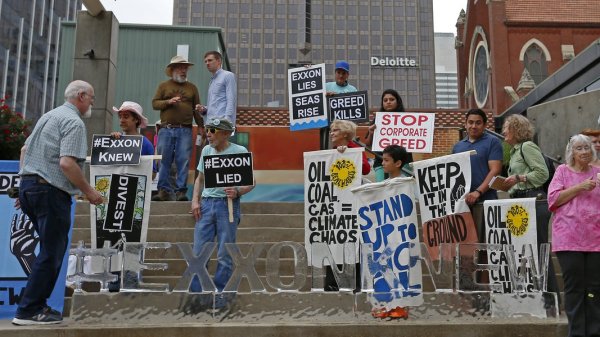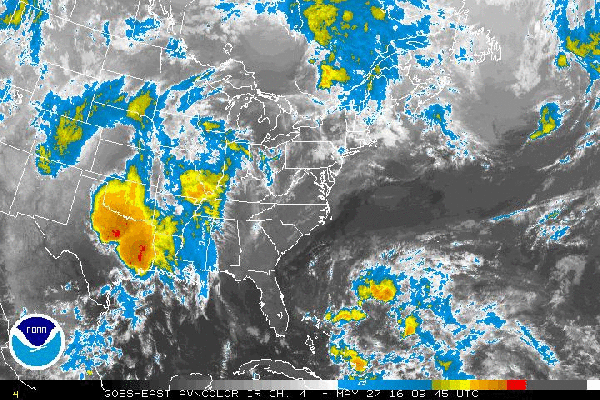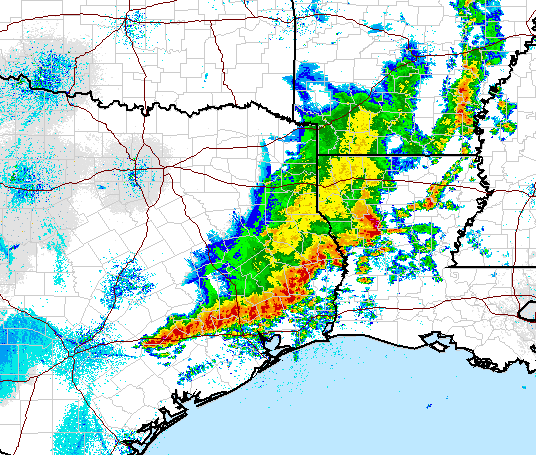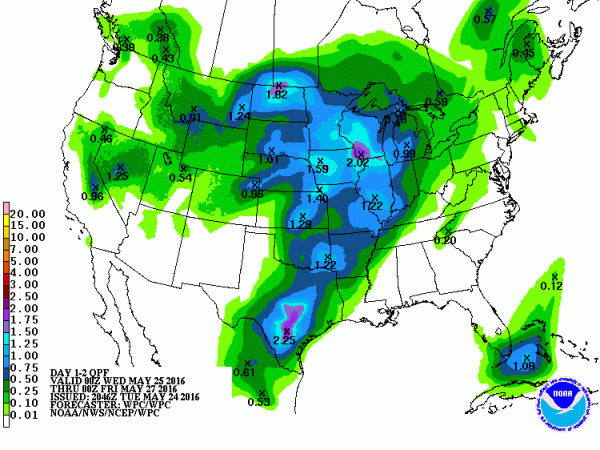Multi-Day ‘Siege of Storms’ Follows Exxon Shareholder Meeting
A
multi-day siege of severe thunderstorms morphed into a major flash
flood event in parts of Texas, Kansas, and other states late Thursday
into Friday, and more severe weather is expected into Friday
night.
*****
27
May, 2016
It
was a stifling hot and humid day that set the scene for the Exxon
shareholder meeting this week. There, in Dallas, Texas on Wednesday,
oil company CEO Rex Tillerson found himself besieged by
environmentalists enraged over his
company’s decades-long campaign to misinform the public on climate
change and
by shareholders concerned about the company’s future prospects. But
what the climate change denying oil company CEO, and even NOAA
weather forecasters, didn’t know was that an extreme rainfall event
worsened by the very smoke and fumes emitted by Exxon was starting to
gather over Southeast Texas — not far from where the shareholder
proceedings were taking place.
(Protesters
urge stockholders to dump Exxon in a push for accountability over
Exxon’s deceptive language and media campaigns related to
emissions-based climate change. Image source: Exxon
Facing Heat Over Climate Change.)
At
the meeting, Rex Tillerson, set to retire in 2017, spewed out his
usual pro-fossil-fuel rhetoric — defending
the myth that oil represents the inevitable mainstay of global energy
and concocting various straw-man arguments imagining oil protesters
filling up cars with gasoline or flying jet airplanes to
join in an array of embittered protests surrounding this week’s
shareholder meeting.
Rallying the board of directors, Tillerson
managed to deflect numerous shareholder attempts to positively modify
Exxon’s behavior with regards to fossil fuel emissions and
responses to climate change. Outside the meeting, protestors called
for keeping oil reserves in the ground, urged Exxon to transition to
a non-fossil fuel based energy company and acknowledge and prepare
for climate change, or
urged Exxon investors to dump stock holdings in response to the
company’s decades-long-effort to stifle effective climate action.
Outside
the meeting, a 13 foot long ice statue spelling out the words —
#ExxonKnew — rapidly melted in the sweltering heat of an atmosphere
roiled by the powerful climate-altering forces fossil fuel entities
like Exxon had already unleashed upon the airs of our world.
‘Siege
of Storms’ Batters Texas
By
Thursday, the day after Exxon’s shareholder meeting, an expansive
trough had extended down from Canada and over Texas. Exploiting this
hole in an increasingly weakened Jet Stream cool, Arctic airs plunged
south. Crossing the Great Plains into Texas, this unstable
atmospheric mass came directly into confrontation with a
super-heated, moist flow rising off the Gulf of Mexico and Pacific
Ocean.
(Very
heavy storms firing off over Southeastern Texas have dumped record
amounts of rainfall over portions of the state and set off a flash
flood emergency. Image source: NOAA.)
Both
the big Jet Stream dip and the extreme moisture content in the airs
over Texas were not normal. Both were new features enabled by a
human-forced (Exxon-forced) warming of the world. For with global
temperatures early this year spiking to 1.4 C above 1880s values, the
planetary atmosphere is now enabled to contain about a ten percent
higher moisture load than during the late 19th Century. It’s a
weird new atmosphere that is now capable of producing storms with
previously unimaginable heights of 70,000 feet over temperate
Latitudes.
And as the current El Nino fades and a temporary 0.2 to
0.4 C dip in global temperatures takes place in the cyclical
transition to La Nina, some of that added, unprecedented excess of
atmospheric moisture is bound to fall out in the form of
never-before-seen rainfall events.
The
storms resulting from what can best be described as a climate mangled
by fossil fuel emissions produced rainfall of an extreme,
record-shattering intensity in a region between Houston, Waco, and
Austin over Thursday and on into Friday. In Brenham, 65 miles to the
northwest of Houston, the 24 hour record for rainfall was shattered
as 17 inches inundated local roads and communities. According to
Weather Underground reports, one
weather observer recorded 19.14 inches of rain after having to empty
an overflowing gauge.
In Bastrop County, emergency crews were overwhelmed by calls for
water rescues as vehicles were rapidly submerged in the heavy flood.
Now, at
least one person is presumed dead and five people are missing in
yet one more tragic storm and flood event sparking off in a record
warm world.
(National
Weather Service Radar shows severe storms and extreme rainfall
sweeping into the Houston region at 4:30 PM EST. Widespread reports
of severe flooding have prompted emergency officials to urge
residents to stay home and avoid life-threatening severe weather
conditions. Image source: National
Weather Service Doppler Radar.)
Both
satellite and weather radar show massive storms continuing to fire
over this region. And GFS model forecasts indicate a strong
likelihood for continued severe thunderstorm formation over Texas on
into both Saturday and Sunday even as heavy rainfall propagates
eastward over the Mississippi River Valley and Southeastern US. So
this extreme event — a‘multi-day
siege of storms’ enabled
by climate change — isn’t over by a long shot. A heavy punch of
incessant flooding that is already prompting warnings of rivers
over-topping banks all
throughout and downstream of the affected region.
Unpredictable
Severe Storms — Another Black Irony of Climate Change Denial
This
most recent extreme rainfall event’s occurrence immediately
following Exxon’s shareholder meeting is yet one more odd and
ironic coincidence of human-caused climate change. A black irony
similar to that of the Fort McMurray fires.
But
perhaps even more disturbing than its coinciding with the Exxon
shareholder meeting was the storm’s unpredictable nature. As noted
above, a basic understanding of atmospheric physics in a warming
world points toward an increasing risk of extreme rainfall events as
El Nino transitions to La Nina. This risk is particularly severe in
the new elongated trough patterns that have tended to form due to
polar amplification and sea ice loss in the Arctic. However, current
weather forecasting appears to be completely unaware of or unwilling
to report on this new risk.
(The
NOAA precipitation forecast issued on May 25 just before Thursday and
Friday’s extreme rainfall event failed to capture any indication
that a 17-19 + inch rainfall event was on the way. An indicator that
warming related extreme rainfall potentials may not be fully plugged
in to current forecast models. Image source: NOAA.)
To
this point — NOAA weather forecasts earlier this week had
identified some risk of severe rainfall over this region. But the
forecasts had only predicted around 3 inches of rainfall in the most
heavily affected areas. The forecast therefore undershot Thursday
rainfall intensity by 14-16 inches. And this makes it look like the
current weather models are having some serious difficultly keeping up
with the human-forced atmospheric changes that are now fully in
swing. Combine this with current weather media’s near complete
blindness (there are noted exceptions — Weather Underground
included) to factors related to human-caused climate change and we
have what could best be described as a hazardous degree of
under-reporting on climate related risk factors. And the result is a
great underutilization of a vast array of weather sensors and
scientific talent that would be capable of providing helpful and
life-saving information if only they were enabled to. But media-wide,
we’re still living and acting as if climate change doesn’t affect
the weather.
As
a result, pretty much everyone — drivers, emergency responders,
government officials, weather forecasters — were caught off-guard
by this particular storm system’s severity and the numerous flash
floods that resulted. So it’s pretty clear that the language of
denial that started in places like the board-rooms at Exxon has
become pretty much all-pervasive. A situation that will need to
change if we’re going to effectively respond to the
ever-more-severe events that are surely coming down the pipe.
Links:
Scientific
Hat tip to Dr. Jeff Masters at Weather Underground
Hat
tip to Cate
Hat
tip to Ryan in New England
Hat
tip to Greg
Hat
tip to DT Lange







No comments:
Post a Comment
Note: only a member of this blog may post a comment.